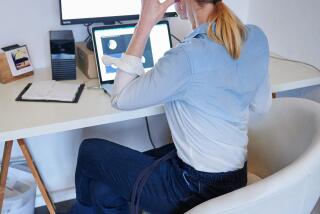Short and to the point
- Share via
THE fitness industry is littered with too-good-to-be-true claims of quick results, but one begs to be at the top of the list: an exercise machine that delivers a full-body workout, incorporating cardio, strength and flexibility, in eight -- eight -- minutes.
Similarities aside, this is no late-night infomercial gadget with a $19.95 price tag and a B-list celebrity endorsement. This is a machine that’s been around for 16 years, weighs 405 pounds and costs $14,615.
The prohibitive price and out-there claims have thus far kept the Range of Motion, or ROM, machine in its own niche. But this seeming cross between a time machine and a souped-up sleigh has just become a little more mainstream.
A tiny Pasadena gym now offers use of the machines -- and only these machines (three of them, to be exact) -- for a monthly membership of $89.
The owner, 35-year-old chiropractor Todd Hewitt, is a believer. He bought one about four years ago, he says, and found that his muscles felt denser, heavier, after two weeks of use. After recruiting a few people to try the device out as well, he decided to open a gym.
The former college football and rugby player acknowledges that the eight-minute claim seems far-fetched, saying it contradicted everything he knew about fitness. “I tried to find some chinks in the armor,” says Hewitt, “but everything just made sense. And the things that didn’t make sense were the things I’d been conditioned about, like the amount of time is too short.”
Although some company-funded research has found the machine to be effective, fitness experts are not convinced of the machine’s transformational powers -- or of the eight-minute claim. They question whether the workout is indeed more efficient than others and whether it’s safe for all users, especially the obese and out of shape.
“I don’t know how you can tell [if the ROM machine is superior] unless you do a head-to-head comparison” with other forms of exercise, says Conrad Earnest, director of the center for human performance and nutrition research at the Cooper Institute in Dallas. (He’s read about the machine but has not tried it.)
As for whether the brief exercise time was enough: “It’s an elusive marketing claim to say this is all you need to do,” he says.
For the record, this is not just any eight-minute workout. It is four minutes of upper-body exercise hell followed by four minutes of rest, then four minutes of lower-body exercise hell. The machine delivers super-high-intensity training in short bursts, far more vigorous than most workouts. The first minute of the workout is tough but doable, but by the second minute lungs start burning and muscles feel maxed out.
The upper-body portion consists of doing rowing movements with chrome bars while seated. But rowing machines supply resistance in only one direction (the pull); this machine provides resistance both pushing and pulling, while the torso bends forward and back. The lower portion works somewhat like a stair climber; legs move small pedals while hands hold onto padded rails. As the resistance changes, so do the intensity and range of movement -- feet can be far apart while pedaling, unlike most stair climbers, on which they’re only inches apart.
Gulping for air at the end is de rigueur. The machine’s appeal lies in the time, not necessarily in the experience.
Hewitt has watched the uninitiated confidently tackle the machines, only to get their comeuppance again and again. It happened to him the first time too. This, he says, is what turns some nonbelievers into believers.
Edward Bellezzo was fairly out of shape and had 50 extra pounds on his 6-foot-2 frame when he started using the ROM machine about three years ago. Following a low-fat diet as well, Bellezzo, 64, says it took him a year to lose 38 pounds and go from a 42 waist to a 38. He’s an unabashed hater of exercise but has stuck with three workouts a week on the ROM machine, saying it’s given him more energy and muscle definition. “What I really like,” he says, “is the time element.” And, he adds, “I can look down and see my toes.”
Professional kayaker Brad Ludden, 24, who lives in Colorado but has worked out on the machine a number of times, says he was “floored” the first time he used it: “I felt like I’d gone kayaking and running. I was tired. I felt like those muscles had really been used.”
Fitness experts don’t totally dismiss the ROM machine’s ability to deliver an intense, effective workout. Several research studies have shown that high-intensity interval training increases cardiovascular efficiency and is a better calorie burner than lower-intensity exercise. But those eight minutes may not offer the best form of exercise for everyone.
“You can make the argument that it produces great results, fat loss and muscle enhancement,” Earnest says, “but we can’t get 75% of the population to walk 30 minutes a day. So expecting people to do even four minutes of intense exercise is asking a lot.”
Carl Foster, president of the American College of Sports Medicine, worries specifically about people with undetected heart disease.
“The young and healthy, already athletic crowd are geared up to do it,” he says. But for others, with underlying disease: “Is that a risk worth taking in the name of efficiency?”
Hewitt hopes to franchise his Quick Gyms and spread the gospel of the eight-minute workout, but he knows he’s still got some convincing to do. “I don’t know that it’s a mainstream thing,” he says. “But I hate to put limitations on it.”


